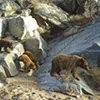Sky Island Alliance
In 1943, Natt N. Dodge wrote an article in Arizona Highways in which he characterized the Chiricahua Mountains of southeastern Arizona as a "mountain island in a desert sea." In 1967, also referring to the legendary Chiricahuas, author Weldon Heald coined the term "sky island" to describe the phenomenon of islands of mountain habitat surrounded by intervening seas of grasslands and desert.
For more than 20 years, the Sky Island Alliance has been working to protect and restore the spectacular mountain ranges that inspired Dodge and Heald. "We work with private landowners, federal agencies, and other nongovernmental organizations in the region to protect and conserve wild places across borders and jurisdictions, largely in Arizona and Sonora, Mexico," said Carianne Campbell, the Tucson-based organization's landscape restoration program manager.
The sky island region of Southern Arizona, extreme southwest New Mexico and northern Sonora is a global biodiversity hot spot. Dramatic differences in elevation, precipitation and vegetation support an incredible array of species, some of which are found nowhere else on earth. A large portion of Arizona's sky island mountain ranges are included in the Coronado National Forest, the biodiversity of which is among the highest of any national forest.
Our region's kaleidoscopic variety of life forms is also boosted by geographic coincidence. It lies at the intersection of several overlapping biotic influences—the Sierra Madre and neotropics to the south, the Rocky Mountains to the north, the Chihuahuan Desert and Great Plains to the east and the Sonoran Desert to the west. Many of the species that inhabit this region are at the edges of their ranges, such as jaguars, coatis and numerous neotropical birds from the south.
If you've spent any time in the hinterlands of this region, you've probably seen Sky Island Alliance's handiwork, whether it's a restored stream bed, a healing erosion scar or a newly built pond full of endangered Chiricahua leopard frogs. Campbell said, "We're out there on the ground with an army of intrepid volunteers, planting native grasses and trees, installing low-tech restoration structures in streams, removing invasive species, assessing the ecological health and restoration potential of springs, building relationships and having a great time."
Sky Island Alliance connects people to place—and citizens to science—in a way that few groups ever have. Their popular "volunteer weekends" take people to stunningly beautiful wild areas for fascinating days of hands-on work and fun nights around the campfire. Volunteers rub shoulders with scientists and experts and learn what makes our region so special, as well as how to protect and restore it.
Over the past two decades, thousands of SIA volunteers have logged tens of thousands of hours working in the wilds of the sky islands, constructing natural features to improve habitat, removing damaging and obsolete human infrastructure, tracking wildlife, monitoring streams and cienegas, and recording the observations and data they collect so that they can be used by landowners and land managers to further the group's goals.
In the process of accomplishing all of that, volunteers also develop a deep camaraderie. "When you get out there to these beautiful places and get your feet wet and your hands dirty, you can't help but build a relationship to the plants, the animals, the land and the good people you're working with," Campbell said.
Volunteer opportunities happen on a regular basis all year long—rain or shine, heat or cold. "We're working on our 2014 calendar of volunteer events right now, and it's full of trips to the Catalinas, Whetstones, Chiricahuas, Pinaleños, Galiuros—not to mention mountain ranges south of the border," Campbell said. "I'm looking forward to experiencing these places with friends, new and old."
To find out more or sign up to get your feet wet and your hands dirty, visit skyislandalliance.org or call Carianne Campbell at 624-7080, ext. 14.
— Randy Serraglio, rserraglio@tucsonweekly.com














